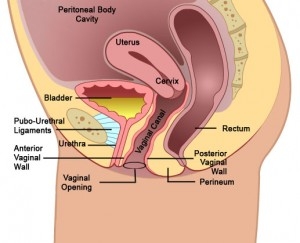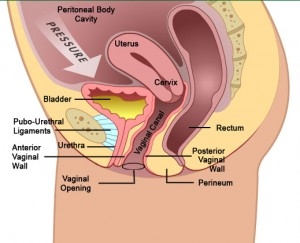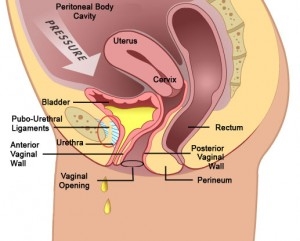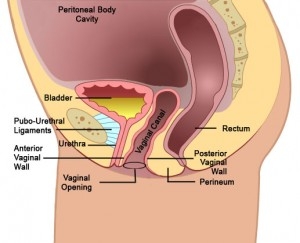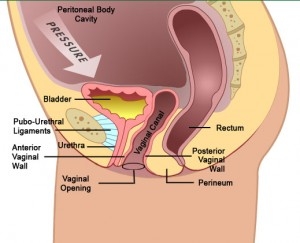What is Urinary Incontinence?
Urinary incontinence is a weakened control of urinary function resulting in urine leakage and can be treatable. The more common form of urinary incontinence presenting itself before elderly care stress incontinence. Stress incontinence is leakage of urine with an increase in abdominal pressure caused by laughing, coughing, sneezing, running, or other physical activities. It’s typically caused by damage to the pubo-urethral ligaments that support the urethra as seen in the images below. This damage can occur during childbirth, although symptoms may not manifest until later in life. It is important to distinguish stress incontinence from urge incontinence. Read below for more information on these differences.
These images show the progression of stress urinary incontinence.
STRESS URINARY INCONTINENCE WITH UTERUS
Original Images Courtesy of BARD Medical – Subject to Copyrights. Labeling Enhanced for Educational Purposes by D. K. Veronikis, MD
The image on the left reflects the normal positioning of the uterus and vaginal canal within the pelvis. Moving from left to right, the image on the far right shows advanced of utero-vaginal prolapse. Additionally, there is weakening of the vaginal tissues in front of the cervix/uterus as well as around the uterus which allows the cervix/uterus to fall into the vaginal canal and through the vaginal opening. Also note, that this prolapse (dropping) has impacted the bladder and the rectum. Complete reconstruction of utero-vaginal prolapse must include repair and elevation of the vaginal apex, by either supporting and/or removing the uterus. Additionally, repair must include support to the remaining pelvic floor organs; the vaginal walls, bladder, rectum, and perineal muscles.
STRESS URINARY INCONTINENCE POST-HYSTERECTOMY
Original Images Courtesy of BARD Medical – Subject to Copyrights. Labeling Enhanced for Educational Purposes by D. K. Veronikis, MD
The image to far left shows normal anatomy with urine in the bladder. The urethra is suspended from the pubic symphysis by the intact Pubo-Urethral ligaments. The center image depicts the urethra under the influence of pressure such as laughing, coughing and sneezing or lifting. The position the urethra is maintained by the intact Pubo-Urethral ligaments and NO stress urinary incontinence or leakage occurs. The image on the far right depicts the urethra under the influence of pressure such as laughing, coughing and sneezing or lifting. The position the urethra is NOT maintained as the Pubo-Urethral ligaments are NOT intact and stress urinary incontinence or leakage occurs when pressure is applied from laughing, coughing and sneezing or lifting releasing small amounts of urine to leak.
What is the Difference Between Stress and Urge Incontinence?
Patients with stress incontinence report leaking urine with laughing, coughing, or sneezing. They also may notice urine leaking with exercise, bending over, or while lifting. The urethral attachments have been compromised in these patients.
Urge incontinence patients report an urgent need to empty their bladder sometimes with very little warning. They may need to empty their bladder frequently because of a small capacity. Typically, the bladder muscle itself is causing their symptoms.
Urodynamics and Voiding Diary
There are multiple tools utilized to help diagnose incontinence, most importantly the history of the patient and her physical exam findings. In our practice, we often utilize an objective bladder test (Urodynamics) to examine the physiology of the bladder during the filling and storage of urine and also evaluate the function of the urethra and the pressure generated during coughing and voiding. This test also helps understand the muscle pattern utilized to empty the bladder of urine. Some patients may not completely empty their bladder, and this is very important information to have when developing treatment plans. The voiding diary is completed over a period of 24 hours while the patient is at home. Information that is collected includes volumes of fluid drank, volumes of urine voided, and times of day that correspond to any episodes of leaking.
Surgical Techniques for Incontinence
Currently, the best surgical cure for stress incontinence is by the placement of a sling. Urge incontinence is most often treated with medications and other behavioral and dietary modifications.

